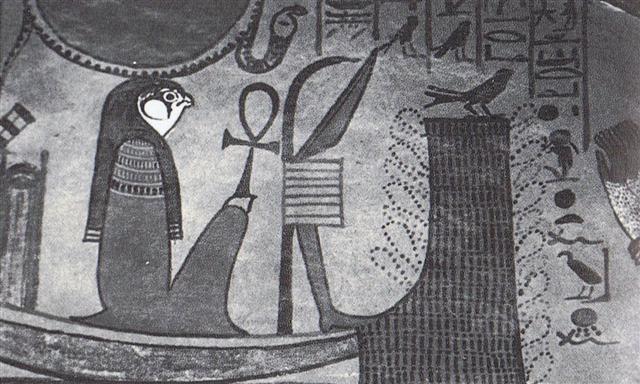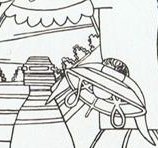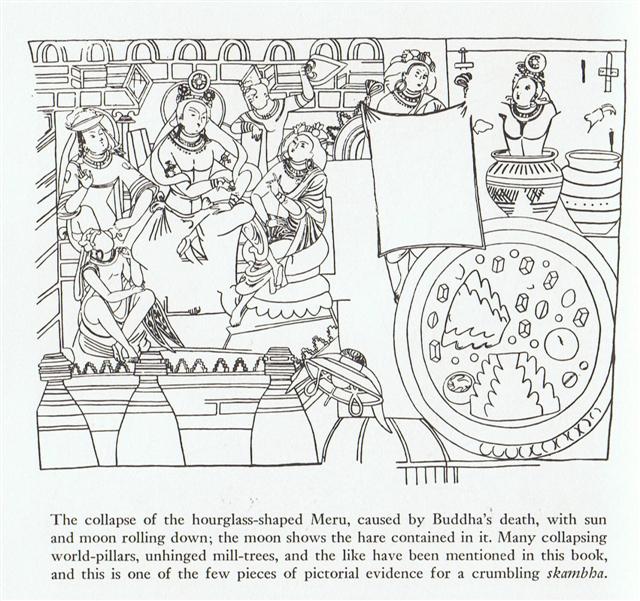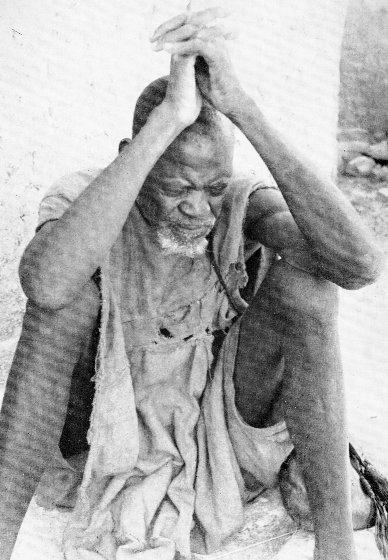And then:
At the time of Bharani
the Babylonian ideas were probably still
influencing the thoughts of the astronomers.
The form of Capricornus, as we still
perceive the constellation, resembles a
ship. It was here the 'water' in the sky
began.
|
ARIES: |
|
1 |
Ashvini |
β and γ Arietis |
Horse's head |
27 = 8
+ 9 |
|
wife of the Ashvins |
Sheratan and Mesarthim |
April 17 (107) |
|
2 |
Bharani |
35, 39, and 41 Arietis |
Yoni, the female organ of
reproduction |
41 = 27
+ 14 |
|
the bearer |
Musca Borealis |
May 1 (121) |
But the Babylonians had their
Cargo Boat earlier and close to where
the Milky Way river was turning up and
leading across the sky to Taurus (Bull of
Heaven):

Probably the Cargo Boat
was south of Sagittarius and corresponding
to our Corona Australis, which upside down
crown according to Hevelius seems to be carrying the
front right leg of the Sagittarian horse
'onboard as cargo':

A part of the old body (from
the old harvest) would secure growth in the
next year. In the night journey of the
morning sun god Horus he had similarly the
leg of a 'harvested companion' in front,
which would secure his return to 'land'. I
have suggested the peculiar arrangement
corresponded to the last Phoenician letter
before the season of fishing:


... The winnowing-fan (λίκνον
[líknon], also meaning a
'cradle') featured in the rites accorded
Dionysus and in the Eleusinian
Mysteries: 'it was a simple agricultural
implement taken over and mysticised by
the religion of Dionysus', Jane Ellen
Harrison remarked. Dionysus Liknites
('Dionysus of the winnowing fan') was
wakened by the Dionysian women, in this
instance called Thyiades, in a
cave on Parnassus high above Delphi; the
winnowing-fan links the god connected
with the mystery religions to the
agricultural cycle, but mortal Greek
babies too were laid in a winnowing-fan.
In Callimachus' Hymn to Zeus,
Adrasteia lays the infant Zeus in a
golden líknon, her goat suckles
him and he is given honey
...
The Babylonian Cargo
Boat, however, had not a leg but
something which looks like a 'black sun'
onboard. Maybe the Cargo Boat was
the headgear of the vanished old king
turned upside down to become a boat.


The
first Greek lettered star in Corona
Australis is
κ, rising
in the day before Vega and 35 days
before Baten Algiedi. Alphekka Meridiana
is α Coronoa Australis, a star which in
rongorongo times rose heliacally 290
days after 0h. At the same time rose Al
Baldah (π Sagittarii, at the back of his
head) and β in Corona Australis, the
last Greek lettered star in the
constellation:
 |
 |
 |
 |
 |
|
Ga1-30 |
Ga2-1 |
Ga2-2 |
Ga2-3 (33) |
Ga2-4 |
|
Furud (94.9) |
Well-22 |
no star listed (96) |
β Monocerotis, ν Gemini
(97.0) |
no star listed (98) |
|
δ Columbae (95.2),
TEJAT POSTERIOR,
Mirzam (95.4), CANOPUS
(95.6), ε Monocerotis
(95.7), ψ1 Aurigae
(95.9) |
|
June 23 |
ST JOHN'S EVE |
25 |
26 (177) |
27 |
|
ºJune 19 |
20 (*91) |
SOLSTICE |
22 |
23 |
|
'May 27 |
28 (*68) |
29 |
30 (*70) |
31 |
|
'Vaitu Potu 27 |
28 (148) |
29 |
30 (150) |
31 |
|
"May 13 |
14 (*54) |
15 (*55) |
16 (136) |
17 |
|
Purva Ashadha-20 |
Kaus Borealis (279.3) |
ν Pavonis (280.4), κ
Cor. Austr. (280.9) |
Abhijit-22 |
|
KAUS MEDIUS, κ
Lyrae (277.5), Tung Hae
(277.7) |
KAUS AUSTRALIS
(278.3), ξ Pavonis
(278.4), Al Athfar
(278.6) |
θ Cor. Austr. (281.0),
VEGA (281.8) |
|
Dec 23 (357) |
CHRISTMAS EVE |
25 |
26 (360) |
27 |
|
ºDec 19 (*273) |
20 |
SOLSTICE |
22 |
23 (357) |
|
'Nov 26 (*250) |
27 |
28 |
29 |
30 (*254) |
|
'Ko Ruti 26 |
27 |
28 |
29 (333) |
30 |
|
"Nov 12 (*236) |
13 |
14 |
15 |
16 (320) |
 |
 |
 |
 |
|
Ga2-5 |
Ga2-6 |
Ga2-7 |
Ga2-8 |
|
ν Puppis (99.2), ψ3
Aurigae (99.4), ψ2
Aurigae (99.5)
Gemma
|
ψ4 Aurigae (100.5),
Mebsuta (100.7) |
Sirius (101.2), ψ5
Aurigae (101.4), ν
Gemini (101.6), ψ6
Aurigae (101.7) |
τ Puppis (102.2), ψ7
Aurigae (102.4) |
|
June 28 |
29 |
30 |
July 1 (182) |
|
ST JOHN'S EVE |
ºJune 25 |
26 (177) |
27 |
|
'June 1 (*72) |
2 |
3 |
4 |
|
'He Maro 1 |
2 |
3 (154) |
4 |
|
"May 18 (*58) |
19 |
20 (140) |
21 |
|
no star listed (282) |
ζ Pavonis (283.4), λ
Cor. Austr. (283.6),
Double Double
(283.7),
ζ
Lyrae (283.8) |
South Dipper-8 |
Sheliak, ν Lyrae
(285.1), λ Pavonis
(285.7)
Atlas
|
|
Φ SAGITTARII
(284.0), μ Cor. Austr.
(284.6), η Cor. Austr.,
θ Pavonis (284.8) |
|
December 28 |
29 |
30 (364) |
31 |
|
CHRISTMAS EVE |
ºDecember 25 |
26 (360) |
27 |
|
'December 1 |
2 |
3 (*257) |
4 |
|
'Ko Koró 1 |
2 (336) |
3 |
4 |
|
"November 17 |
18 |
19 |
20 (324) |
 |
 |
 |
 |
|
Ga2-9 |
Ga2-10 |
Ga2-11 |
Ga2-12 |
|
θ Gemini (103.0), ψ8
Aurigae (103.2),
Alhena
(103.8), ψ9 Aurigae
(103.9) |
Adara (104.8) |
ω Gemini (105.4),
Alzirr
(105.7), Muliphein
(105.8), Mekbuda (105.9) |
7h (106.5) |
|
no star listed (106) |
|
July 2 |
3 |
4 (185) |
5 |
|
ºJune 28 |
29 (*100) |
30 |
ºJuly 1 (182) |
|
'June 5 |
6 |
7 (*78) |
8 |
|
'He Maro 5 (156) |
6 |
7 |
8 |
|
"May 22 |
23 |
24 (144) |
25 (*65) |
|
Ain al Rami (286.2), δ
Lyrae (286.3), κ Pavonis
(286.5), Alya (286.6) |
ξ Sagittarii (287.1), ω
Pavonis (287.3), ε
Aquilae, ε Cor. Austr.,
Sulaphat (287.4), λ
Lyrae (287.7),
Ascella, Bered
(Ant.) (287.9) |
Uttara Ashadha-21 |
19h (289.2) |
|
NUNKI (288.4), ζ
Cor. Austr. (288.5),
Manubrium (288.8), ζ
Aquilae (288.9) |
λ Aquilae (Ant.)
(289.1), γ Cor. Austr
(289.3), τ Sagittarii
(289.4), ι Lyrae
(289.5), δ Cor. Austr.
(289.8) |
|
January 1 (366) |
2 |
3 |
4 |
|
ºDecember 28 |
29 |
30 (364) |
31 (*285) |
|
'December 5 |
6 |
7 |
8 (342) |
|
'Ko Koró 5 |
6 (*260) |
7 |
8 |
|
"November 21 (325) |
22 |
23 |
24 (*248) |
 |
 |
 |
 |
 |
|
Ga2-13 |
Ga2-14 |
Ga2-15 |
Ga2-16 |
Ga2-17 |
|
Wezen (107.1), τ Gemini
(107.7), δ Monocerotis
(107.9) |
no star listed (108) |
λ Gemini (109.4), Wasat
(109.8) |
no star listed (110) |
Aludra (111.1), Propus
(111.4), Gomeisa
(111.6) |
|
July 6 |
7 (188) |
8 |
9 |
10 |
|
ºJuly 2 |
3 |
4 (185) |
5 |
6 (*107) |
|
'June 9 |
10 |
11 |
12 |
13 (*84) |
|
'He Maro 9 |
10 |
11 |
12 |
13 (164) |
|
"May 26 |
27 |
28 (*68) |
29 |
30 (150) |
|
Al Baldah-19 |
Aladfar (291.1), Nodus
II (291.5), ψ Sagittarii
(291.6), θ Lyrae (291.8) |
ω Aquilae (292.1), ρ
Sagittarii (292.6), υ
Sagittarii (292.7) |
Arkab Prior (293.0),
Arkab Posterior, Alrami
(293.2), χ Sagittarii
(293.6) |
Deneb Okab (294.0), α
Vulpeculae (294.9) |
|
AL
BALDAH,
Alphekka Meridiana
(290.1),
β
Cor. Austr.
(290.2) |
|
January 5 (370) |
6 |
7 |
8 |
9 |
|
ºJanuary 1 |
2 |
3 (*288) |
4 |
5 (370) |
|
'December 9 |
10 (344) |
11 (*265) |
12 |
LUCIA |
|
'Ko Koró 9 |
10 (*264) |
11 (345) |
12 |
LUCIA |
|
"Nov 25 (329) |
26 (*250) |
27 |
28 |
29 |
 |
 |
 |
|
 |
 |
 |
|
Ga2-18 |
Ga2-19 |
Ga2-20 (50) |
Ga2-21 |
Ga2-22 |
Ga2-23 |
|
Ghost-23 |
Al Dhirā'-5 /
Punarvasu-7 |
ANA-TAHUA-VAHINE-O-TOA-TE-MANAVA |
α Monocerotis
(115.4), σ Gemini
(115.7) |
κ Gemini (116.1),
POLLUX
(116.2), π Gemini
(116.9) |
Azmidiske (117.4) |
|
ρ GEMINI
(112.1), Eskimo
Nebula (112.2)
Antares
|
CASTOR
(113.4) |
υ Gemini (114.0),
Markab Puppis
(114.7), ο Gemini
(114.8),
PROCYON
(114.9) |
|
July 11 |
12 (193) |
13 |
14 |
15 (196) |
16 |
|
ºJuly 7 |
8 |
9 |
10 |
11 |
12 (193) |
|
'June 14 |
15 |
16 |
17 (*88) |
18 |
19 |
|
'He Maro 14 |
15 |
16 |
17 (168) |
18 |
19 |
|
"May 31 (151) |
"June1 |
2 (*73) |
3 |
4 |
5 |
|
ν Aquilae (Ant.)
(295.0), Albireo
(295.5) |
μ Aquilae (296.3), ι
Aquilae (Ant.)
(296.8), κ Aquilae
(Ant.) (296.9) |
ε Sagittae (297.1),
σ Aquilae (Ant.)
(297.4), Sham
(297.8) |
β Sagittae (298.0),
χ Aquilae (298.3), ψ
Aquilae (298.8) |
υ Aquilae (299.1),
Tarazed
(299.3), δ Sagittae
(299.6), π Aquilae
(299.9) |
Sravana-23 |
|
ζ Sagittae (300.1),
ALTAIR
(300.3), ο Aquilae
(300.5), Bezek
(300.8) |
|
January 10 |
11 |
12 (377) |
13 |
14 |
15 |
|
ºJanuary 6 |
7 (372) |
8 |
9 |
10 (*295) |
11 |
|
'December 14
|
15 |
16 (350) |
17 |
18 |
19 |
|
'Ko Koró 14 |
15 |
16 |
17 |
18 |
19 (*273) |
|
"November 30 |
"December 1 |
2 (336) |
3 |
4 |
5 (*259) |
|
Belly of the Sea Beast |
Baten Kaitos (26.6) |
April 16 (472) |
'March 20 (80) |
"March 6 (66) |
|
ζ Ceti |
27 + 365 = 392 = 8 * 49 |
26 + 80 = 106 = 472 - 366 |
472 - 27 = 445 = 80 + 365 |
472 - 41 = 431 = 66 + 365 |
|
Belly of the Sun |
July 31 (*132) |
'July 4 (*105) |
"June 20 (*91) |
|
395 - 183 = 212 |
368 - 183 = 185 |
354 - 183 = 171 |
|
The City |
Al Baldah (290.1) |
January 5 (370) |
'December 9 (343) |
"November 25 (329) |
|
π Sagittarii |
290 |
290 + 80 = 370 |
370 - 27 = 183 + 160 |
370 - 41 = 183 + 146 |
|
Belly of the Goat |
Baten Algiedi (315.8) |
January 30 (395) |
'January 3 (368) |
"December 20 (354) |
|
ω Capricorni |
316 + 365 = 681 = 3 * 227 |
315 + 80 = 395 = 30 + 365 |
395 - 27 = 368 (= 183 + 185) |
395 - 41 = 354 (= 183 + 171) |
In
rongorongo times Antares rose with the
sun in November 25, but in the time of
Bharani this occurred 41 days
earlier, in day 329 - 46 = 283 ("October
10).
... The four males and the four females
were couples in consequence of their
lower, i.e. of their sexual parts. The
four males were man and woman, and the
four females were woman and man. In the
case of the males it was the man, and in
the case of the females it was the
woman, who played the dominant role.
They coupled and became pregnant each in
him or herself, and so produced their
offspring.
But in the fullness of time an obscure
instinct led the eldest of them towards
the anthill which had been occupied by
the Nummo. He wore on his head a
head-dress and to protect him from the
sun, the wooden bowl he used for his
food. He put his two feet into the
opening of the anthill, that is of the
earth's womb, and sank in slowly as if
for a parturition a tergo.
The whole of him thus entered into the
earth, and his head itself disappeared.
But he left on the ground, as evidence
of his passage into that world, the bowl
which had caught on the edges of the
opening. All that remained on the
anthill was the round wooden bowl, still
bearing traces of the food and the
finger-prints of its vanished owner,
symbol of his body and of his human
nature, as, in the animal world, is the
skin which a reptile has shed ...
(Marcel Griaule, Conversations with
Ogotemmêli.)

Greek
κ located at the
beginning of a
constellation could
mean 'reversal'.
This phenomenon
occurs not only in
Corona Borealis but
also in Lyra. The return
to land could have
been described with
positioning κ at the
beginning instead of
at the end.
Reversal
is in G evidently
illustrated by the
'giving arms' turned
around in Ga2-8
(July 1 / December
31) and Ga2-10
(Alhena / Nunki)
|



















